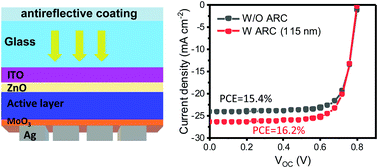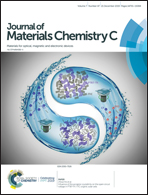Mesoporous silica hybrids as an antireflective coating to enhance light harvesting and achieve over 16% efficiency of organic solar cells†
Abstract
Grafted with hexamethyldisiloxane (HMDS), mesoporous silica nanoparticle (MSN) hybrids have been synthesized and explored as an antireflective coating (ARC) to enhance the power conversion efficiency (PCE) of non-fullerene organic solar cells (OSCs). The ARC consisting of HMDS–MSN hybrids and silica oligomer binders can increase the transmittance of the OSC glass substrate from a maximum value of around 90% to 95%, allowing more visible light to be absorbed by the photoactive layer of OSCs and be converted to free charges. After coating of an ARC, the short-circuit current density and PCE of PBDB-T:ITIC OSCs increased from 15.5 mA cm−2 and 9.7% to 16.1 mA cm−2 and 10.1%, with those of PBDB-T-2F:BTP-4F OSCs increasing from 25.2 mA cm−2 and 15.4% to 26.7 mA cm−2 and 16.2%, which is among the highest reported efficiency of single-junction OSCs in the literature. Meanwhile, the fill factor and open-circuit voltage of those OSCs remain unaffected. Our results suggest that an ARC is a superior approach to enhance the efficiency of organic solar cells.



 Please wait while we load your content...
Please wait while we load your content...